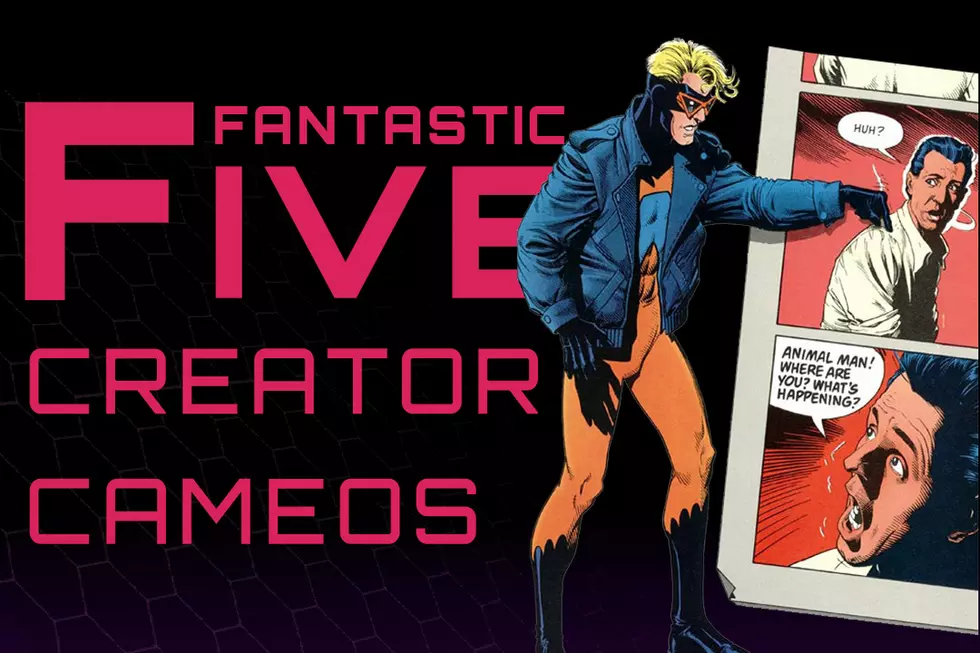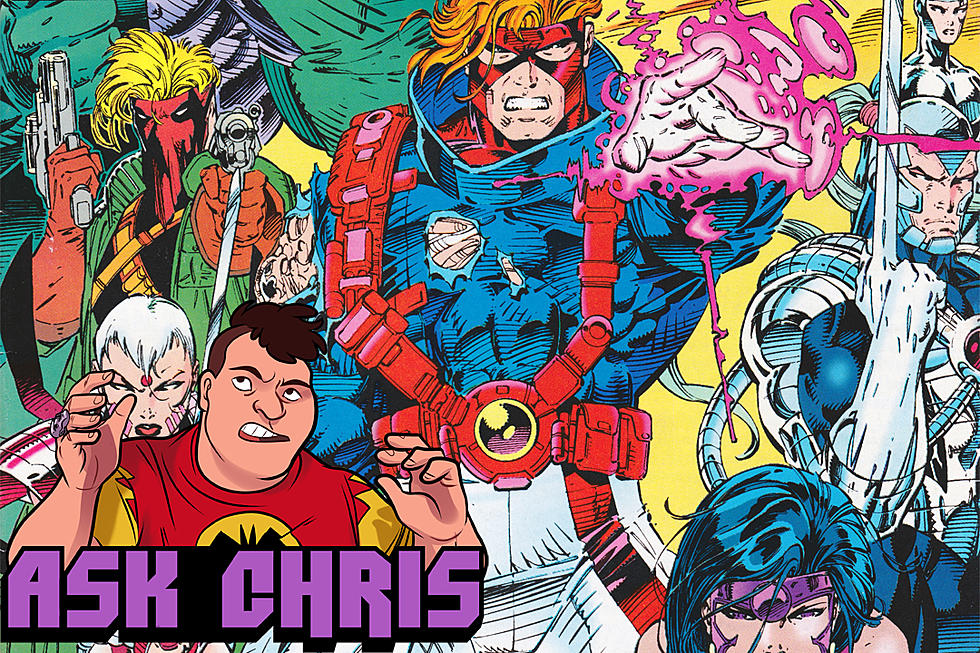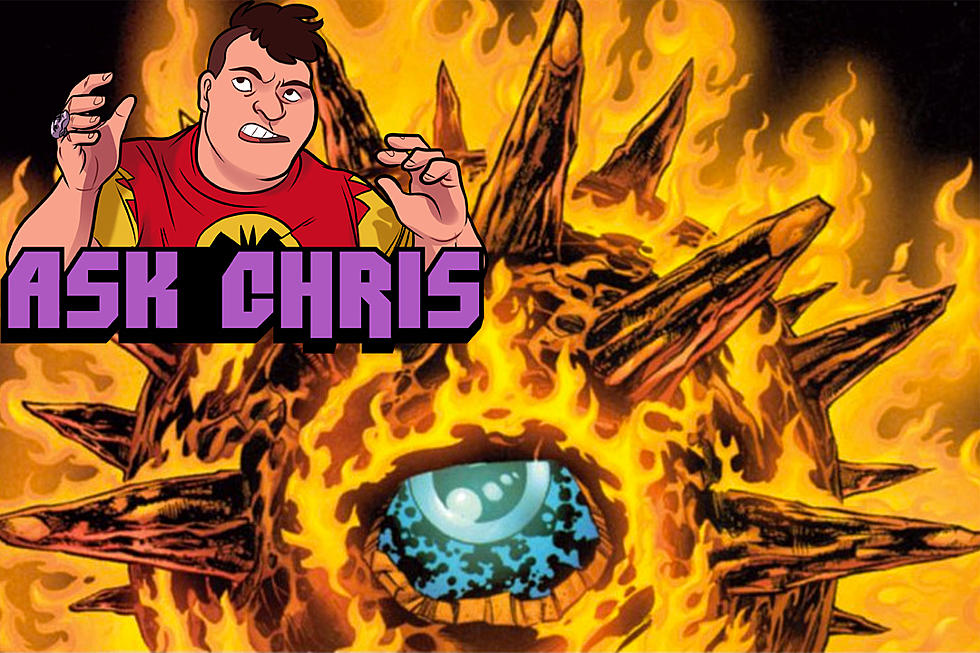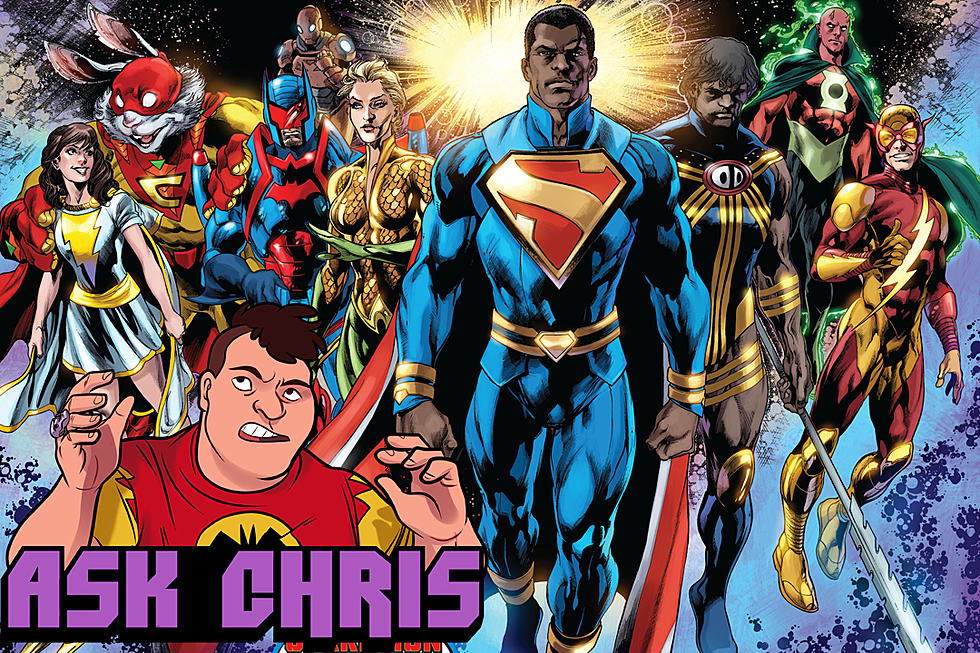
The Expert’s Guide To HBO’s ‘True Detective’ And Weird Comic Book Fiction
In a moment of exquisite bromance, the final scene of HBO’s True Detective saw Rust Cohle’s black shell finally crack. Wounded, his arm round his friend Marty Hart’s shoulder for support, Cohle looks up at the stars and offers us hope for the first time in the series.
...once there was only dark, if you ask me the light’s winning.
Which brings us to comic books and this:
Originally spotted by author and Alan Moore biographer Lance Parkin, this panel from the closing pages of Moore and Gene Ha’s Top 10 strongly suggests itself as the inspiration behind Marty and Rust’s optimistic send off. Especially when you take into account True Detective creator Nic Pizzolatto’s claim that Moore and Grant Morrison were the first writers to excite him about the possibilities of storytelling.
So with everyone looking to solve the many remaining mysteries of True Detective, it’s tempting to ask: are comic books the key? Pizzolatto’s spectacular Moore crib aside, I’d go with with a big no. Ain’t nothing going to settle the debate around Carcosa let alone Marty Hart’s hot dating skills, but comics do represent a largely unexplored and appropriately strange route into the show. So without further ado here’s our by no means exhaustive guide to True Detective and weird comic books.
SPOILER WARNING: The following contains major spoilers for True Detective, From Hell and some of The Invisibles.
The Nightmare Factory

Story by writers
Artwork by various artists
Published by Fox Atomic Comics
Buy it on AmazonWant to trace the genealogy of True Detective’s atmosphere of “aluminum and ash”? You could start with William Faulkner’s forays into the dark heart of his home state of Mississippi, The Sound and the Fury, and Absolom! Absolom! — and that would be super-great — or you could go with a comic book adaptation of the works of Thomas Ligotti.
The Nightmare Factory, an adaptation of the short story anthology of the same name, featuring commentary by the author himself, was my first contact with Ligotti’s septic fictions, and a very good introduction it was too. Ligotti’s work is peculiarly suited to comic book translation in that his take on horror is strongly conceptual and doesn’t rely on visceral scares better suited to other formats. His heavy emphasis on atmosphere over plot is another plus in this regard. Both veteran horror-comic artists, Ben Templesmith and Ted McKeever’s twisted lines and rotten palettes capture the sickness and foreboding that lurks beneath Ligotti’s prose. While the scripts by Joe Harris and Stuart Moore sensibly steal liberally from the original texts, ensuring that Ligotti’s doomy voice underpins the book.
The ties between True Detective and Ligotti have been discussed at length elsewhere. Short story: Nic Pizzolatto’s a big fan — Ligotti’s all over the show. Longer story: Ligotti is both a writer of horror fiction and a well known philosophical pessimist, a position which holds that optimistic world views are unjustifiable and damaging. Extreme adherents, such as fun guy Ligotti, go as far as to claim that life is fundamentally meaningless and that the human race would be better off marching hand in hand into extinction than to continue to suffer in this “human thresher.” Ligotti sees self-consciousness as a monstrous paradox: a void that thinks it’s something. Much like the zombies or living dolls of Ligotti's stories but worse because zombies have the decency to be merely mindless nothings rather than self-regarding, hubristic nothings. The trouble is, Ligotti is worryingly convincing.
Does all this remind you True Detective fans of anyone? I ask because Ligotti’s thinking, set out in his scariest tome, a non-fiction work cheerfully titled The Conspiracy Against the Humanity, is pretty much the dummies’ guide to Rust Cohle and the corrupt world he finds himself in. That said, Ligotti’s prose — The Nightmare Factory included — confronts the reader with the same stuff just with a fantastical bent: reality peeling back to reveal the evil of the human condition, hideous conspiracies, all against a backdrop of a world in decline.
If that doesn’t describe True Detective’s set-up then I don’t know what does.
Further reading:
The Nightmare Factory Volume 2 by various writers and artists
The Conspiracy Against the Human Race by Thomas Ligotti
Teatro Grottesco by Thomas Ligotti
A Short History of Decay by E.M. CioranFrom Hell

Story by Alan Moore
Artwork by Eddie Campbell Eddie Campbell
Published by Top Shelf Productions
Buy it on AmazonPerhaps Moore and Campbell’s finest work, From Hell is less a detective story than an effort to unpick the weave of myth and history. Equal parts an unflinching commentary on Victorian England (spoilers: it totally sucked), a police procedural and a metaphysical treatise, it’s a heady book, giddying in its scope and seamless in its execution.
We could talk all day about the formal ties between True Detective and From Hell. Both are concerned with the nature of stories and storytelling, both use fractured time as a narrative device, both are centered on powerful conspiracies and the hunts for the killers who lurk at their hearts. But perhaps the strongest point of convergence is to be found in Moore and Pizzolatto’s villains and their crimes.
As most readers will already know, The King in Yellow is an anthology of short stories by American writer Robert W. Chambers, four of which are connected by references to a madness-inducing play called The King in Yellow, and a malevolent supernatural entity of the same name. Elements from the book, including the eponymous king, the cursed land(?) of Carcosa and the Yellow Sign would later be appropriated by the godfather of pessimist horror H.P Lovecraft and incorporated into his Cthulhu Mythos, a cabal of unknowable powers from beyond space and time intent on humanity’s annihilation. The key words here being “beyond space and time.”

It's like in this universe, we process time linearly forward but outside of our space-time, from what would be a fourth-dimensional perspective, time wouldn't exist, and from that vantage, could we attain it we'd see our space-time would look flattened, like a single sculpture with matter in a superposition of every place it ever occupied…
-Rust Cohle
Like True Detective, From Hell puts forward the pop-physics notion that time and space can be conceived of as a unity, observable in its entirety from a higher dimensional perspective. Rust calls this hyper-structure a “flat disc,” From Hell circles around the concept of the “fourth dimension.” There’s a whole thing here about hyper-objects as metaphors for comic books and TV shows, two-dimensional fictions navigable by three-dimensional beings which I assure you Moore and Pizzolatto are well aware of. This is also the moment to zero in on how both fictions ask hard questions about the nature of story. On the one hand we have Moore’s Jack the Ripper staring out of the page at us, testing the boundaries of his own comic; on the other we have Rust’s Cohle, mister walking, talking auto-critique, who throws the stories that make up True Detective’s world into cold, harsh light.

But back to True Detective’s killer, Errol Childress. What does all this have to do with him? To answer that question we need to take a closer look at Jack and his grisly efforts to straddle the fourth dimension through the blood sacrifice of London’s dispossessed women. In many ways this is a stock genre trope, the serial killer hoping to be transformed by the act of killing. See everything Thomas Harris has ever written, from the Tooth Fairy’s desire to metamorphose into William Blake’s Red Dragon to Buffalo Bill’s misguided approach to gender reassignment in The Silence of the Lambs. What’s different here is that Moore’s Ripper actually succeeds. He literally ascends to a weird vantage point from which he can see across time.
Which brings us back to Errol.
...when [Errol] says, “My ascension removes me the disc in the loop,” he’s describing the cosmology of eternal recurrence of various characters, including Cohle and Reggie Ledoux hit upon, and he’s hitting upon his personal mythology… ...He believes the murders ritually enacted over a period of time, upon his death, permit him an ascension that removes him from the Karmic wheel of rebirth.
-Nic Pizzollato
What we have here is mad man’s way out of the Ligotti-esque scenario described by Rust, namely that reality is a prison where we’re all trapped, eternally reliving the same godawful lives over and over again. Errol plans to break free of his personal torment by removing himself from space-time in much the same way that the ending of From Hell sees a senile, incarcerated Jack drift into death then soar out over history into infinity.
To understand what Moore is getting at it probably helps to know something about his personal philosophy, which I’m sure Nic Pizzolatto does given that most Moore fans I’ve ever met do. Very simply, and without wishing to paint the guy as a wacko, Moore thinks that mythic structures stand outside space and time, and that our world is composed of the stories that arise from these platonic forms. As Moore makes plain in From Hell’s must-read appendices, he considers Jack the Ripper to be a modern day myth, hence Jack’s ultimate ascendence into the ether, there to live on as the quintessential serial killer narrative of our age.

The question of whether or not True Detective’s Childress achieves his supernatural aims and becomes some sort of multi-dimensional monstrosity aside, it could be argued that he’s attempting a similar kind of mythological transcendence. As From Hell demonstrates, we do remember serial killers, we want to remember serial killers, not as people but as monstrously compelling stories. Is Childress a horribly abused child who went on as an adult to abuse and kill children, or is he the avatar of the King in Yellow? Both might be true, but I know which vision shines brighter.
Further reading
The King in Yellow by Robert W. Chambers
The Call of Cthulhu by H.P. Lovecraft
The Grand Design by Stephen Hawking and Leonard Mlodinow
The Mindscape of Alan Moore (film)Neonomicon

Story by Alan Moore
Artwork by Jacen Burrows
Published by Avatar Press
Buy it on AmazonDisappointed that True Detective didn’t go full on supernatural? Neonomicon could be for you.
Technically two miniseries in the one volume, this collected edition brings together a comic book adaptation of Alan Moore’s Lovecraftian horror story The Courtyard and a follow up title written directly for the comics medium by Moore himself: Neonomicon. To say that both are an uncomfortable read would be an understatement. Written when Moore was in a “bad mood,” Neonomicon has come in for a lot of flack for its graphic depictions of sexual violence. Which isn’t to say that The Courtyard is light reading, what with its pseudo-nazi protagonist and abundant gore, just that it doesn’t feature alien entities engaging in rape.
Neonomicon and True Detective are both examples of what I like to call gnostic noir, a sub-genre of detective fiction that mixes in a smattering of horror genre tropes and asks questions about the nature of reality or morality or some other philosophical doodadery. Think Twin Peaks or Blue Velvet, maybe Grant Morrison’s The Mystery Play, and you’ll see what I’m getting at. The difference between True Detective and most things on my gnostic noir list is that it never commits to any kind of supernatural presence. Some strangeness bleeds in at the edges, but it’s all intimation, all tease, and for some in the audience that was frustrating. The good news for that crowd is that Neonomicon is True Detective off the chain.

Featuring its very own socially alienated lead with extraordinary powers of perception, Aldo Sax, Neonomicon focuses on two murder investigations, each with links to a cult that worships Lovecraftian deities and a mysterious antagonist who goes by the handle Jonnie Carcosa. Ostensibly a procedural piece in much the same vein as True Detective, Neonomicon ultimately wants to have it’s many-angled cake and eat it. Instead of creepy murals we get murals that are actually portals to another dimension. Think Ledoux’s LSD and Rust’s ominous flashbacks are a fun way into the dark heart of True Detective’s mystery? Neonomicon will see that and raise you a drug made of language that opens its users up to the cosmic insanity seething behind our world (a not so oblique King in Yellow reference). Think Rust had a hard time in Carcosa? Neonomicon’s FBI agents come off waaaaay worse when they pay a visit to the cultists’ lair in the comic’s closing chapter.
Maybe you only think you wanted to meet the King in Yellow. You have been warned.
Further reading
The Mystery Play by Grant Morrrison and Jon J. Muth
Fatale by Ed Brubaker and Sean Phillips
Twin Peaks (TV show)
Blue Velvet (film)Seven Soldiers of Victory: Mister Miracle

Story by Grant Morrison
Artwork by Pascal Ferry
Published by DC Comics
Buy it on AmazonOn the face of it, Grant Morrison and Pascal Ferry’s Mister Miracle doesn’t have a whole lot in common with True Detective. A high octane, psychedelic superhero adventure that sits within the broader Seven Soldiers project, Mister Miracle tells the story of Shilo Norman, a super-escape artist who battles to free the world from the clutches of a dark god.
I contemplate the moment in the garden, the idea of allowing your own crucifixion.
-Rust Cohle in True Detective
Dig deeper, however, and things start to get really interesting. Like Rust, Shilo is trapped in a flat disc reality up until the final moments of the story, albeit a black hole rather than “matter in superposition.” Like Rust, Shilo is held prisoner in a “life trap” (Rust uses this very term, as does Darkside, Mister Miracle’s diabolic antagonist), an endless cycle of meaningless lives. Like Rust, Shilo is haunted by the loss of a loved one he couldn’t save.
Darkside and Childress each present us with a vision of a world of pain and suffering that the hero must overcome if they’re to move on with their lives. In Mister Miracle this conflict is literal. In one memorable scene, Shilo must fend off attacks by demonic cars, in another he’s tortured to death by plastic men with bolt cutters. In true comic book fashion, Darkside’s ultimate weapon, Omega, isn’t merely a nasty lens through which to view reality, it’s a sentient life-story that seals its prey behind bars of misery and hopelessness. The only way to defeat it is to literally come to terms with it — I’m talking an actual conversation here — and offer up a better story, one that includes the possibility of forgiveness.
This competing story dynamic cuts to the heart of True Detective. As I’ve noted above, Rust serves an autocritical function. His profoundly reductive point of view shines an unforgiving light on the stories that make up True Detective’s world, be they Marty tales about family and masculinity, Reverend Therriot’s brand of religious revivalism, or Rust’s very own “cathartic narratives,” the tools he uses to extract confessions from criminals. The trick the show plays is to fool the viewer into thinking that Rust’s take, while horrible, has a firmer hold on the show’s reality than anyone else’s. It does this in a number of ways: Matthew McConaughey’s considerable charm for starters, and by presenting Rust as a guy who has little if anything to gain by being right. I mean, this isn’t a fella who enjoys his perspective or much of anything for that matter. More subtly, the show works to reinforce the dominance of Rust’s worldview by aligning it with the iconography and philosophy of the villain’s, thereby lending it a quasi-supernatural authority.
Of course, Rust’s story is just that, a story, very likely designed to lessen the pain and guilt he carries in the wake of his daughter’s death. In Rust’s twisted mind, her passing is a blessing, an escape from “the sin of being a father.” The cost of this anesthetic is high -- the possibility of happiness -- but it’s a price Rust’s willing to pay if it means he doesn’t have to feel as much -- and, hey, drink will do the rest.
Ultimately, Rust, like Mister Miracle, finds himself face to face with a competing story he can’t overcome. In the darkness — again, actual darkness — both characters discover a world which includes love and implicitly forgiveness. Suddenly all that talk of life traps and Omega and flat discs and Carcosa starts to look very shaky. Other possibilities present themselves, other stories, like the hope that Rust and Cohle can at last truly be friends.

Addendum: Intriguingly, True Detective presents us with an alternative, positive spin on reality early on in the form of Reverend Therriot’s sermon. What’s extra good is that it has roughly the same shape as the worldview Rust winds up with. As for why you didn’t catch this the first time around, that’s because the cut that aired has Therriot’s speechifying firmly in the background. Here's a different edit which features the sermon in full.
The Invisibles

Story by Grant Morrison
Artwork by various artists
Published by Vertigo
Buy it on AmazonAnd finally we arrive at what is in all likelihood the show’s biggest conceptual inspiration, Grant Morrison’s magnum opus and the benchmark by which his work continues to be judged, The Invisibles.
For those of you out there who enjoy True Detective but who haven’t yet explored this particular metaphysical rabbit hole, it might be time to bite the bullet and give it a try. I warn you though, The Invisibles is not for the faint hearted. The comic’s frequently smug tone, its slightly naff fascination with all things Britpop, its disinterest in tying up loose ends, not to mention the fact that one of its characters — a supercool bondage assassin terrorist — is clearly intended as an analogue for the writer himself, are enough to scare off many readers midway through the first volume, but persist with it and The Invisibles emerges as a “difficult” work of a more rewarding kind. Stay with me and I’ll try to convince you.
Roughly speaking, The Invisibles tells the story of an occult war raging behind the scenes of The World We Know, with two possibly equally evil secret organizations vying for control of human destiny and the planet. Specifically, the comic focuses on the events of this war’s final decade and follows a cell of activists working on behalf of one of the aforementioned creepy conspiracies, the Invisibles, comprising a transvestite shaman, a time displaced witch, a potty-mouthed messiah from Liverpool, a revenge driven ex-cop and Grant Morri-- I mean a super dangerous, kill-crazy bondage assassin. Along the way it incorporates everything from cutting edge pop-science, to 1970s sci-fi texts, to Karl Marx, to medieval Sufism, which means it’s a very mixed bag indeed. So if and when you arrive at the end of this portion of the article you’re tempted to pick it up, get ready for some very abrupt abrupt scene shifting and more meta-textual referencing than comic book annotator Jess Nevins could shake a stick at.
Having said that, I think it’s probably the case that most True Detective fans don’t mind their entertainment flaunting its influences, so I’m sure many of you couldn’t care less when I tell you The Invisibles does too. However it’s not just via their ever expanding frontiers that these artworks meet, but also via the subject matters which define their hazy and grasping borders. It’s fair to say that The Invisibles shares many of True Detectives’ concerns, themes, symbols and tropes, but before it hands them off to other authors it runs with them about as far as it can go
Psychic detectives investigating occult conspiracies? Look no further than Division X:

Black suns? The eclipse door at the end of the comic’s third volume.

Spaghetti monsters? Mmmhmm.

Raggedy demons conjured out of old drapes and bone? The Archons got it locked.

Wicker man-style animal mask wearing, child sacrificing bad guys? Yup. Pagan rituals and time magic? Yup and yup again.
But the connections run deeper than just window dressing. It’s in the ideas informing all this other stuff that the links between The Invisibles and True Detective begin to really convince.
The Horror! The Horror!
Whatever else you may think, you are machines. Biological Robots, operated by electrical firing and chemical spasms…. You in your chaotic state may experience our efforts in value laden terms; feelings of degradation, shame and humiliation are common. Those states are simply the reaction of a damaged subjective unit during its return to the objective reality of the machine. “Individuality” is the name you give your sickness.
Thus speaks Mr. Quimper, the mind controlling incubus who plagues The Invisibles throughout volume two… but, you know, you could be forgiven for confusing the guy with Rust Cohle. Put simply, there are two philosophical strands warring within the comic’s pages, the expansive and anarchic paradigm of the Invisibles versus the mechanistic and socially Darwinian worldview espoused by their opposite, the Outer Church, of whom Quimper is an agent. Tragically, up until True Detective’s final curtain, the same could be said of Rust.
But we love all that, don’t we, True Detective fans, all that horror and misery? My point is, The Invisibles can be that way too. All you have to do is decide the Outer Church is right and track their point of view instead of their enemies’. Seen from the Outer Church’s gloomy perspective, the world and all its discontents manifests not dissimilarly from Rust and Ligotti’s threshing machine analogy discussed above. It’s dressed up in cosmic sci-fi imagery, but what is the terrible future promised by the Outer Church where “the beasts inherit the Earth’”and humanity is herded into “pens” like cattle in an “infinite death camp of tomorrow” other than a metaphor for our simply giving in to the animal side of our nature and submitting to extinction?
For The Invisibles’ most committed enemy Sir Miles Delacourt, just as with Rust, pretty much all of the truths we hold dear are manifestly hollow and empty. Human progress? Forget it. As Miles explains to his Invisible opposite seconds before killing him:
Beyond this there are no aeons. There is no evolutionary process. There is only the machine forever and everywhere...
So strike one. What’s next? Religion? In True Detective Rust describes religion as a virus, and while it’s not explicitly denigrated in these terms within The Invisibles, the accusation is certainly there. The comic often refers to language and ideas in viral and bacterial terms and was one of the first popular narratives to introduce the meme to the general public. It’s easy to infer what the Outer Church’s earthly agents, the Myrmidons, would make of the elaborate conceptual palaces erected by the faithful. Sir Miles would understand religion not simply as a virus, but as a highly adaptive super-resistant strain. In fact he’d go further, he’d understand all our thoughts that way, right down to the biggest delusions of all, free will and an individual, integral self.
You’re not bad, it’s not you. There’s a weight and it’s got its fish-hooks in your soul…. It’s not you. You were dragged to the bottom by that same weight. Listen to me, son: you’ve got one way out and it’s by the grace of God…… You, me, people, we don’t choose to feel our feelings. There is grace in this world and there is forgiveness, but you have to ask for it.
-Rust Cohle in True Detective
I always found Rust’s confessionals to be amongst the show’s creepier scenes. The way he creates such a high degree of intimacy between himself and the individual he seeks to destroy. It runs deeper than sexual violence, it’s like he wants to touch souls with them before pulling away and seeing them consigned to the flames. Except that Rust doesn’t believe in souls. For all its religious trappings, what Rust is really describing is a universe bereft of a director. There is no choice, just the dead weight of history dragging us where it will (probably somewhere horrible!) and the God invoked is an absent one. How can we achieve redemption without free will? All that is left for us is to make peace with chaos and our inner robot, to forgive ourselves, a self which, as Rust explains in the first ten minutes of the very first episode, is nothing more than an illusion.
These ideas find an oblique but disturbing correlate in The Invisibles’ story arc, “American Death Camp,” during which the character called Boy, an ex-cop and peculiarly vengeful Invisible, has her personality taken apart by enemy agents adept at psychic warfare. Some readers interpret Morrison’s reduction of Boy to a selfless zero as a tacit admission that he didn’t know what to do with the team’s only black member, and that may be true, but the way he goes about it is horrifyingly effective nevertheless. After being abducted by the enemy cell, Boy’s sense of personhood is shattered by the revelation that her current identity is a cover story within a cover story within a cover story within which her true self has become trapped. The memories of each of these lives are somehow stimulated into re-emerging simultaneously and the ontological shock which ensues softens her up for the final blow. There is a real “Boy” underneath all these layers and it’s anything but human.

The picture says it all. It’s a visceral and near perfect metaphor for everything Rust describes. What we call consciousness doesn’t belong to us — it’s something else, from outside, an aggregate of warring memes --nothing more than a monstrous parasite, and our bodies are slaves to its will. This is the philosophical pessimist’s take in a nutshell. There is no meaning. There is no creator. There are no souls. All that is left from us is to stagger around blindly in the dark.
It gets worse.

Crushed Beer Cans and Eternal Suffering!
I guess you couldn’t find a better symbol for the abject awfulness of it all than a wizened alcoholic christening his can of Lone Star “The Universe” before flattening it out and chucking it in the trash. Life’s got pretty bad when the only things that carry any meaning for you are dead bodies and rubbish beer. That’s bottom, surely? Turns out It isn’t.
Rust isn’t just reducing the universe to a) poison and b) garbage, he’s also venting forth about exactly why in his view things are so bad. See, it’s not simply that human beings are damaged subjective units or whatever, it’s that reality itself is evil. The game was rigged from the start.
It’s a problem of geometry… In our subjective universe we experience three dimensions of space and one of time. However I believe time, like space, has more than one dimension. Think of timespace as a multi-dimensional, self perfecting system in which everything that has ever, or will ever, occur, occurs simultaneously. I believe timespace is a kind of object, a geometrical supersolid.
-Takashi Satoh in The Invisibles
In The Invisibles, the Outer Church and Rust’s conception Spacetime is one thing, which means that every moment, from the universe’s alpha to its omega, is happening right now. This entails that time as we perceive it is an illusion and to someone or something outside of this reality all of our joys and our sorrows would be arrayed alongside each other, all equally viewable, like the events in a comic or a beer can flattened out so that its sides and top end are present simultaneously.
What Rust is hung up on is the sorrowful part of the equation. Forget the joys or even the most banal aspects of our lives like doing the shopping, hanging out with our mates or going to the toilet, it’s all about the pain! And because Rust can’t see past the fact that all our miseries are eternal, he’s understandably somewhat depressed. Towards the end of The Invisibles, the aforementioned Sir Miles is introduced to a maxim which neatly sums up this dreary worldview (one that inverts Hassan Sabbah’s and The Invisibles’ famous credo): “Everything is true, nothing is permitted.”
Rust and Miles inhabit a universe, then, of pulverizing pointlessness, the sheer weight of which crushes all their hopes and dreams underfoot. It’s a universe in which there is no room to act, even to breath, and sees both of them committing what amounts to slow motion suicide. Miles with his dark gods and black magic, Rust with his drink.
Which leads us effortlessly to the next stop on this not-so-whirlwind tour of the similarities between the show and the comic book.
Time Worms and Spaghetti Monsters
The body is not one member, but many. Now are they many, but of one body.
-Rust Cohle in True Detective
If our words are circles, theirs are bubbles.
-Jack Frost in The Invisibles
So…. Rust Cohle swigging back his Lone Star time-stretched into infinity. What would that look like?
A grimier version of something like this?

Rust’s drug altered perception may have something to do with why he finds Brane Theory so appealing, the way his flashbacks cause objects to bleed and blur into each other, like space-time congealing. However he got there, brain damage of otherwise, there’s something fourth dimensional, Invisible, about his visions.

One of the implications of all events existing within the same hyper-moment is that all flesh does too -- that all of us are, literally, in some way physically connected to our entire past and future. But not only that, because we all stem from someone else, right back to the first single celled organism which spawned the human race and preceding that the planet, stars and big bang/crunch which birthed and ultimately will end it all, it turns out we’re connected to everything else as well. The tree of life isn’t metaphor, but an actual fact, and we’re all twigs extending out from the central stem of closely packed matter at the dawn of time. This reality, which on the surface appears so complicated, is in the end just a simple bifurcating program, and if we could only see it from the outside, then not only would we be struck by its elegance, but we’d see patterns reproducing themselves with slight variations at different scales all across the timeworm’s body, like the aforementioned twigs or leaves on a tree. Forgive my metaphysical noodling here, it is leading somewhere I promise.
The day-to-day life of the elderly, like that of the magician, is filled with an extraordinarily high level of coincidence.
-Lady Edith Manning in The Invisibles
Why does Rust see the birds form the swirling tattoo just prior to discovering all that creepy business in the rundown church? Why does he smell aluminum at both the investigation’s beginning and its end? And does that loony child murdering bastard bloke who first introduces the idea of flattened out time circles or whatever really know what’s going to happen next? After all, a black star does rise -- a void right through his head. If Nic Pizzolatto is as familiar with Morrison’s work as all that, and he clearly is, then it’s likely that an Invisible reading of these events is built in and actively encouraged. What would that look like? Well for a start, all this talk of predestination and prognostication wouldn’t just be empty words, some of these characters might actually be able to stand outside of time and witness the recurring patterns. Rust and the crazy bastard bloke’s awareness really could track backwards or forwards along the worm in other words. So, yeah, all this is in there, even if it doesn’t have to be in there, if you know what I mean.
Time worms, a whole new take on spaghetti monsters, don’t you think?

Actually this isn’t a new idea to either Morrison or Alan Moore. Way back in the late eighties, in a short story called Lovecraft in Heaven, Morrison toyed with idea that the original spaghetti monsters, Lovecraft’s Great Old Ones, were in fact the human race seen from “above” (think of Cthulhu’s squid head as an upside down tree of life and you’ll get what I mean), a billion eyed and tentacled super-intelligence — or as Morrison calls it, the “Bioplasm” — existing both within and outside time. The thing is, in Grant’s story, when he gazed down/up/whatever at it, to Lovecraft’s dismay the bioplasm gazed right back.
Radio Carcosa
You see, man will not be man…. he will be like them…. star-headed…. in the 2012…. the trans continuum… Like the Old Ones! Like THEM!
- Sir Miles Delacourt in The Invisibles
You couldn’t look at my face
- The Harlequin in The Invisibles
His face, his FAAAAAAAACE!
- Kelly in True Detective
The real Lovecraft buffs amongst you will notice that the Yellow King in The Invisibles is an amalgamation of two Lovecraftian creepies — the King in Yellow and Nyarlathotep. This is likely because both of these characters have at one time or another been rationalized by various contributors to the Cthulhu Mythos as messengers, or avatars, of the fifth dimensional intelligence(s) lurking in wait beyond ordinary, time-bound human perception. They’re the human face of Lovecraft’s Old Ones, and a bridge between us and them.
While Chambers is wholly disinterested in explaining away his king, and The King in Yellow is all the better for it, by contrast Morrison finds clever ways of working him into his Invisible cosmology. Much is made, for instance, of the King’s famous line from the original anthology where a woman asks him to take off his mask and he responds, “Why Madam, I wear no mask!” In The Invisibles this re-emerges at a key point in the narrative: the debonair Invisible Mr. Six’s defection to the other side. In this scene, after explaining to Six that he can’t make this transition without putting aside all his “cover personalities,” the King reiterates the point that his face and his “mask” are one and the same, only in this instance his words take on a curiously metaphysical dimension.
The figure of the king, then, with his veiled "burkha" mask, becomes symbolic of the idea that normal human consciousness cannot penetrate the beyond -- to do so one has to abandon the ego completely. And so Six’s act of betrayal, his union with everything he is not, the Outer Church, affects his own transformation from man to fourth dimensional spaghetti monster. But there are other ways of affecting self-annihilation. Darker ways. That complete and utter betrayal of all things most humans hold dear: murder.
It was for my initiation into the Anti-Brotherhood…. I had to prove I was beyond compassion. Beyond humanity….I had no compassion…. no compassion….. URRRRRRRRHHHHH…
-Sir Miles Delacourt in The Invisibles, mourning his lost humanity after killing a friend
Most of us understandably balk at the idea that there could be anything transcendent about the willful taking of another life, but sacrifice has long been part of religious ritual the world over. Obviously this is just speculation but it seems to me that it is precisely because murder is an enormous transgression that it carries such a powerful charge for Errol Childress. Like Sir Miles, or Jack the Ripper in From Hell, Childress transparently uses his crimes to connect to the reality behind the everyday, a world, as in The Invisibles, where time and space fuse and may be navigated, and into which both murderer and victim are transported. Why the King in Yellow? Because Childress may feel he is enacting ultimate reality’s will on Earth, and because for the children he kills he is at once "the key, the guardian and the gate" -- a torn veil opening the way into the post-human.
And just as in The King in Yellow and the comic, of course you can’t look at his true face. The domain of the Great Old Ones, eternity itself, is beyond human conception -- invisible.
A scream’s as good a response as any.
The Black and the White
...all your life: all your love, all your hate, all your memory, all your pain - it was all the same thing. It was all the same dream. A dream that you had inside a locked room. That dream about being…. a person.
And like a lot of dreams, there’s a monster at the end of it.
-Rust Cohle in True Detective
It’s never clear what Carcosa is. Okay, we know it’s a place, a network of tunnels bedecked with skulls and weird sculptures in a psychopath’s back garden, but there’s another Carcosa too, the one Reggie Ledoux mutters about shortly before having his mind blown out, a monster’s web in which Rust and Marty are at that point in the story caught. Only maybe it’s more than this. Perhaps — and given the parallels between the dream Rust describes above and Carcosa the actual geographical space, I’d say this is clearly intended to be the case — Carcosa is symbolic of our lives: a murky maze of pain, confusion and death.
It is in this final sense that Childress can be most readily identified as the Yellow King, a monster who stands outside this maze. Who owns it. Whose voice can be heard emanating from no particular direction but everywhere inside it, almost as though he, like the dark gods of The Invisibles and H.P. Lovecraft’s books, can permeate or intersect with it from anywhere, from “above.” If we follow Rust’s analogy to its conclusion, then the monster, Childress, is ourselves shorn of personhood. He’s the brute and bloody reality Sir Miles knows is always immanent and whose presence Rust, too, must find a way to live with. As it turns out, however, he’s also something else, something far more... benevolent.
All of us meet the forgotten, each to his kind… When fear is all there is, there is no fear. Eternal pain is no longer pain. When we remember them recognize them for what they are they are, they no longer enslave us.-
-John a Dreams in The Invisibles
This is your voice echoing off the walls of God.
-Elfayed in The Invisibles
It’s no coincidence that the final confrontation at Carcosa’s heart involves so much rupturing and piercing. True Detective is often faulted for being a very macho show, a criticism I’ve found myself nodding along with, but seen this way the violence takes on an interesting dimension. Both True Detective and The Invisibles arrive at the same diagnosis for the protagonists’ pain -- alienation. Rust and Sir Miles might have peeked behind the veil, but neither of them have really incorporated this understanding or its implications into their lives. Sir Miles’ response is classically Nietzschean, he sides with darkness and makes up his mind to be king of the sh*t heap, Rust just gets lost in a sea of dead children and failed relationships, but in the end both of them are wallowing in their own disillusionment. They know intellectually that everything’s part of the same thing, the problem is they see that thing as fundamentally grotesque and so recoil from it. They don’t have the courage to approach, to make friends with the monster and see where that takes them.
I don’t want to spoil The Invisibles, so I won’t tell you what happens to Sir Miles, but by the end of True Detective Rust is effectively broken open. It’s as though the whole world comes rushing in through his wounds, the oneness and unity he’s so horrified by suddenly becoming vivid reality. And it’s scary, but only at first. After crossing over into the timeless zones where everything is one and nothing ever dies, he’s permitted a final goodbye to both his father and his daughter (thinking about it, there’s a similar supercontextual reunion in The Invisibles too, centering on a character equally as nihilistic as Rust….) — and later, when he returns to the quotidian, that rarest of jewels in the life of Rust Cohle: a friend. It doesn’t matter if any of this is “real.” In dying, Rust finally comes to terms with the darkness and finds his loved ones — the capacity to love — waiting there. Where else?
In the final analysis Rust's locked room could stand in for the universe or our own heads, it doesn’t matter, the point is that we’re all in this together, we’re all suffering together. In a world of suffering where God is absent and only we create meaning, then imagination and compassion are perhaps more appropriate and useful responses than despair or rage. It is only by employing these tools, the ones which connect us to other people and things and actually get us somewhere, that we stand a chance of transcending.
And when the Archons come and it all turns inside out with scary miracles. It’s only all the things you left out when you were building your little house called ‘Me’, ey?
- Jack Frost in The Invisibles, at the end of everything
Needless to say, this breaking open — or breaking out — occurs before the curtain falls on The Invisibles too, when humanity is absorbed into the fifth dimension, or as it’s nicknamed in the comic, the Supercontext. What I find compelling about the comic’s final act, even now that I’m less enamored with some of its more mystical pretensions, is the idea, evident at the end, that by interfacing with the Supercontext humankind has switched places with its fifth dimensional prison wardens. That we’ve gone from being passive and acted upon, from being thrown into the world, to becoming participants capable of truly owning ourselves and our environment. As Jack Frost the buddha of this new age explains:
We made gods and jailers because we felt small and alone. We let them try us and sentence us and, like sheep to the slaughter, we allowed ourselves to be sentenced….
Only now we’re free.
What Rust is trying out at the end there with all that stuff about the stars is just a test run. He’s tentatively taking on the responsibility of being an agent, someone unafraid to act and be in the world. Someone capable of transposing his own meanings on things regardless of whether they contained any in the first place, instead of just giving up and sinking into the bottomless gravity well of his own personal black star, the death of his child. Now who knows he might go the full Kierkegaard route, take the leap of faith and find religion, but something tells me Rust is too much of a realist for that. For the present I suspect Rust’s true solace is in finding a way out of the prison cell of depression and misery he’s been trapped in for most of his adult life, and that’s good enough.
Hopefully now he’ll can it with all those mansplainy lectures.*
*If only he’d listened to that revivalist preacher (an undercover Invisible if ever there was one) then maybe we’d have been spared a few.
Further reading
The Illuminatus! Trilogy by Robert Shea and Robert Anton Wilson
The Pseudonomicon by Phil Hine
Valis by Philip K Dick
The Magic Christian by Terry Southern
The Meme Machine by Susan Blackmore
Hyperspace by Michio Kaku
More From ComicsAlliance






























